Experimental Measurement of Wave Field Variations around Wave Energy Converter Arrays
Abstract
:1. Introduction
2. Materials and Methods
2.1. Experimental Set-Up
Description of WEC Models
2.2. Methodology
2.2.1. Polychromatic Wave Packet
2.2.2. Data Acquisition
2.2.3. Array Layouts
2.2.4. Testing Procedure
- The water depth was set to 550 mm in the test area in front of the wave paddles.
- Wave probes were calibrated and a still water test was recorded.
- Waves were generated continuously by the wave paddles, using the polychromatic wave packet defined in Table 1.
- A minimum time of 3 min was allowed for wave disturbance patterns to reach a stable state before commencing data capture.
- Surface elevation data was recorded by 32 wave probes spaced at 150 mm centres in a linear array traversing the wave basin, perpendicular to the wave propagation direction.
- Data was recorded for a total of 64 s in each position before the gantry was moved a distance of 150 mm in the longitudinal direction.
- If necessary, probes were raised over obstacles and lowered back into position behind the obstacle.
- Steps 5–7 were repeated to map an area of 4.65 m by 5.1 m in the centre of the basin.
2.2.5. Data Analysis
3. Results
4. Discussion
5. Conclusions
Acknowledgments
Author Contributions
Conflicts of Interest
References
- Falnes, J. A review of wave-energy extraction. Mar. Struct. 2007, 20, 185–201. [Google Scholar] [CrossRef]
- Clément, A.; McCullen, P.; Falcão, A.; Fiorentino, A.; Gardner, F.; Hammarlund, K.; Lemonis, G.; Lewis, T.; Nielsen, K.; Petroncini, S.; et al. Wave energy in Europe: Current status and perspectives. Renew. Sustain. Energy Rev. 2002, 6, 405–431. [Google Scholar] [CrossRef]
- De, O.; Falcão, A.F. Wave energy utilization: A review of the technologies. Renew. Sustain. Energy Rev. 2010, 14, 899–918. [Google Scholar]
- Uihlein, A.; Magagna, D. Wave and tidal current energy—A review of the current state of research beyond technology. Renew. Sustain. Energy Rev. 2016, 58, 1070–1081. [Google Scholar] [CrossRef]
- O’Boyle, L.; Doherty, K.; van’t Hoff, J.; Skelton, J. The Value of Full Scale Prototype Data—Testing Oyster 800 at EMEC, Orkney. In Proceedings of the 11th European Wave and Tidal Energy Conference (EWTEC), Nantes, France, 6–11 September 2015; pp. 1–10.
- Yemm, R.; Pizer, D.; Retzler, C.; Henderson, R. Pelamis: Experience from concept to connection. Philos. Trans. R. Soc. A Math. Phys. Eng. Sci. 2012, 370, 365–380. [Google Scholar] [CrossRef] [PubMed]
- Fiévez, J.; Sawyer, T. Lessons Learned from Building and Operating a Grid Connected Wave Energy Plant. In Proceedings of the 11th European Wave and Tidal Energy Conference (EWTEC), Nantes, France, 6–11 September 2015; pp. 4–9.
- Folley, M. Numerical Modelling of Wave Energy Converters. State-of-the-Art Techniques for Single Devices and Arrays, 1st ed.; Elsevier: Amsterdam, The Netherlands, 2016. [Google Scholar]
- Zanuttigh, B.; Angelelli, E. Experimental investigation of floatingwave energy converters for coastal protection purpose. Coast. Eng. 2012, 80, 148–159. [Google Scholar] [CrossRef]
- Stratigaki, V.; Troch, P.; Stallard, T.; Forehand, D.; Kofoed, J.P. Modelling of wave attenuation induced by multi-purpose floating structures used for power supply and coastal protection. Coast. Eng. Proc. 2014. [Google Scholar] [CrossRef]
- Abanades, J.; Greaves, D.; Iglesias, G. Coastal defence using wave farms: The role of farm-to-coast distance. Renew. Energy 2015, 75, 572–582. [Google Scholar] [CrossRef]
- Fitzgerald, C.; Thomas, G. A preliminary study on the optimal formation of an array of wave power devices. In Proceedings of the 7th European Wave and Tidal Energy Conference, Porto, Portugal, 11–14 September 2007.
- Child, B.F.M.; Venugopal, V. Optimal configurations of wave energy device arrays. Ocean Eng. 2010, 37, 1402–1417. [Google Scholar] [CrossRef]
- Borgarino, B.; Ferrant, P.; Mecanique, L. De, Impact of the separating distance between interacting wave energy converters on the overall energy extraction of an array. In Proceedings of the 9th European Wave and Tidal Energy Conference, Southampton, UK, 5–9 September 2011.
- Babarit, A. On the park effect in arrays of oscillating wave energy converters. Renew. Energy 2013, 58, 68–78. [Google Scholar] [CrossRef]
- Renzi, E.; Dias, F. Relations for a periodic array of flap-type wave energy converters. Appl. Ocean Res. 2013, 39, 31–39. [Google Scholar] [CrossRef] [Green Version]
- Folley, M.; Mendes, L.; Fortes, C.J.; Brito-Melob, A.; Sarmento, A. A Review of Numerical Modelling of Wave Energy Converter Arrays. In Proceedings of the ASME 31st International Conference on Ocean, Offshore and Artic Engineering, Rio de Janeiro, Brazil, 1–6 July 2012.
- Venugopal, V.; Smith, G.H. Wave climate investigation for an array of wave power devices. In Proceedings of the 7th European Wave and Tidal Energy Conference, Porto, Portugal, 11–14 September 2007; pp. 1–10.
- Vidal, C.; Méndez, F.J.; Díaz, G.; Legaz, R. Impact of Santoña WEC installation on the littoral processes. In Proceedings of the 7th European Wave and Tidal Energy Conference, Porto, Portugal, 11–14 September 2007; pp. 1–7.
- Palha, A.; Mendes, L.; Fortes, C.J.; Brito-Melo, A.; Sarmento, A. The impact of wave energy farms in the shoreline wave climate: Portuguese pilot zone case study using Pelamis energy wave devices. Renew. Energy 2010, 35, 62–77. [Google Scholar] [CrossRef]
- Le Crom, I.; Sarmento, A. Maritime Portuguese Pilot Zone for Wave Energy Conversion: Modelling Analysis of the Impact on Surfing Conditions. In Proceedings pf the 2nd International Conference on Ocean Energy (ICOE), Brest, France, 15–17 October 2008.
- Troch, P.; Beels, C.; De Rouck, J.; De Backer, G. Wake Effects Behind a Farm of Wave Energy Converters for Irregular Long-Crested Waves. In Proceedings of the 32nd International Conference on Coastal Engineering, Shanghai, China, 30 June–5 July 2010; pp. 1–15.
- Beels, C.; Troch, P.; De Visch, K.; Kofoed, J.P.; De Backer, G. Application of the time-dependent mild-slope equations for the simulation of wake effects in the lee of a farm of Wave Dragon wave energy converters. Renew. Energy 2010, 35, 1644–1661. [Google Scholar] [CrossRef]
- Millar, D.L.; Smith, H.C.M.; Reeve, D.E. Modelling analysis of the sensitivity of shoreline change to a wave farm. Ocean Eng. 2007, 34, 884–901. [Google Scholar] [CrossRef]
- Smith, H.C.M.; Millar, D.L.; Reeve, D.E. Generalisation of wave farm impact assessment on inshore wave climate. In Proceedings of the 7th European Wave and Tidal Energy Conference, Porto, Portugal, 11–14 September 2007; pp. 1–7.
- Alexandre, A.; Stallard, T.J.; Stansby, P.K. Transformation of Wave Spectra across a Line of Wave Devices. In Proceedings of the 8th European Wave and Tidal Energy Conference, Uppsala, Sweden, 7–10 September 2009; pp. 1–9.
- Silverthorne, K.E.; Folley, M. A New Numerical Representation of Wave Energy Converters in a Spectral Wave Model. In Proceedings of the 9th European Wave and Tidal Energy Conference, Southampton, UK, 5–9 September 2011.
- Chang, G.; Ruehl, K.; Jones, C.A.; Roberts, J.; Chartrand, C. Numerical modeling of the effects of wave energy converter characteristics on nearshore wave conditions. Renew. Energy 2016, 89, 636–648. [Google Scholar] [CrossRef]
- Ashton, I.G.C.; Johanning, L.; Linfoot, B. Measurement of the effect of power absorption in the lee of a WEC. In Proceedings of the 28th International Conference on Ocean, Offshore and Arctic Engineering, Honolulu, HI, USA, 31 May–5 June 2009; pp. 1–10.
- Tseng, R.S.; Wu, R.H.; Huang, C.C. Model study of a shoreline wave-power system. Ocean Eng. 2000, 27, 801–821. [Google Scholar] [CrossRef]
- Viviano, A.; Naty, S.; Foti, E.; Bruce, T.; Allsop, W.; Vicinanza, D. Large-scale experiments on the behaviour of a generalised Oscillating Water Column under random waves. Renew. Energy 2016, 99, 875–887. [Google Scholar] [CrossRef]
- Ashlin, J.S.; Sundar, V.; Sannasiraj, S.A. Effects of bottom profile of an oscillating water column device on its hydrodynamic characteristics. Renew. Energy 2016, 96, 341–353. [Google Scholar] [CrossRef]
- Haller, M.C.; Porter, A.; Lenee-bluhm, P.; Rhinefrank, K.; Hammagren, E. Laboratory Observations of Waves in the Vicinity of WEC-Arrays. In Proceedings of the 9th European Wave and Tidal Energy Conference, Southampton, UK, 5–9 September 2011; pp. 3–9.
- O’Boyle, L. Wave Fields around Wave Energy Converter Arrays. Ph.D. Thesis, Queen’s University Belfast, Belfast, UK, 2013. [Google Scholar]
- O’Boyle, L.; Elsaesser, B.; Whittaker, T. Methods to Enhance the Performance of a 3D Coastal Wave Basin. Ocean Eng. 2016. submitted. [Google Scholar]
- Falcão, A.F.O.; Henriques, J.C.C. Oscillating-water-column wave energy converters and air turbines: A review. Renew. Energy 2016, 85, 1391–1424. [Google Scholar] [CrossRef]
- Whittaker, T.J.T. A Hydrodynamic Study of Wave Energy Converters with Particular Reference to Oscillating Water Columns. Ph.D. Thesis, Queen’s University Belfast, Belfast, UK, 1981. [Google Scholar]
- Lamont-Kane, P. Physical and Numerical Modelling of Wave Energy Converter Arrays. Ph.D. Thesis, Queen’s University Belfast, Belfast, UK, 2015. [Google Scholar]
- Sheng, W.; Alcorn, R.; Lewis, A. On thermodynamics in the primary power conversion of oscillating water column wave energy converters. J. Renew. Sustain. Energy 2013, 5. [Google Scholar] [CrossRef]
- Rogers, D.; Bolton King, G. Wave Generation Using Ocean and Wave; Edinburgh Designs Ltd.: Edinburgh, UK, 1997. [Google Scholar]
- O’Boyle, L.; Elsaesser, B.; Folley, M.; Whittaker, T. Assessment of Wave Basin Homogeneity for Wave Energy Converter Array Studies. In Proceedings of the 9th European Wave and Tidal Energy Conference, Southampton, UK, 5–9 September 2011.
- Band, Y.B. Light and Matter. Electromagnetism, Optics, Spectroscopy and Lasers; John Wiley & Sons Ltd.: Chichester, UK, 2006. [Google Scholar]
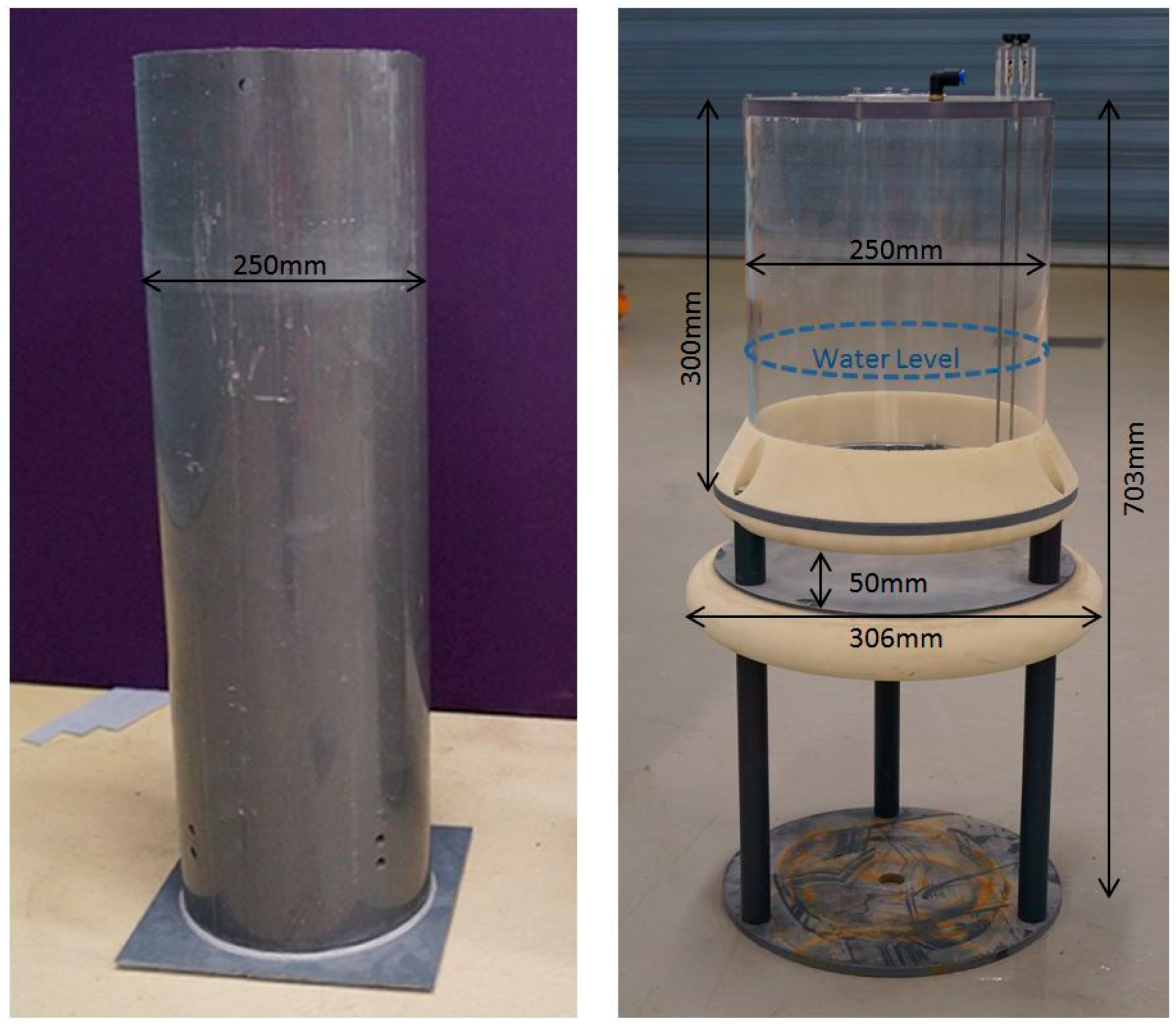
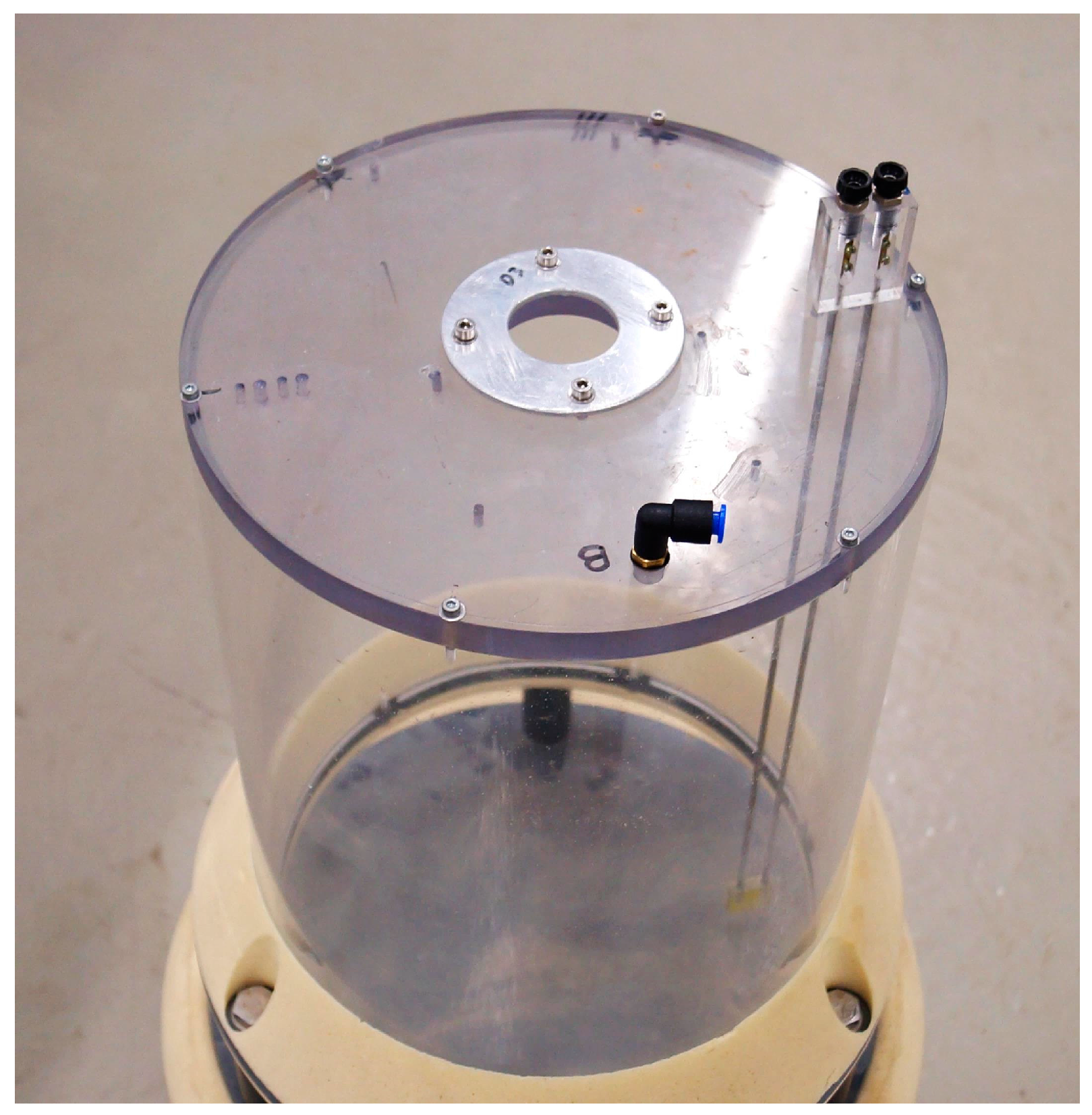
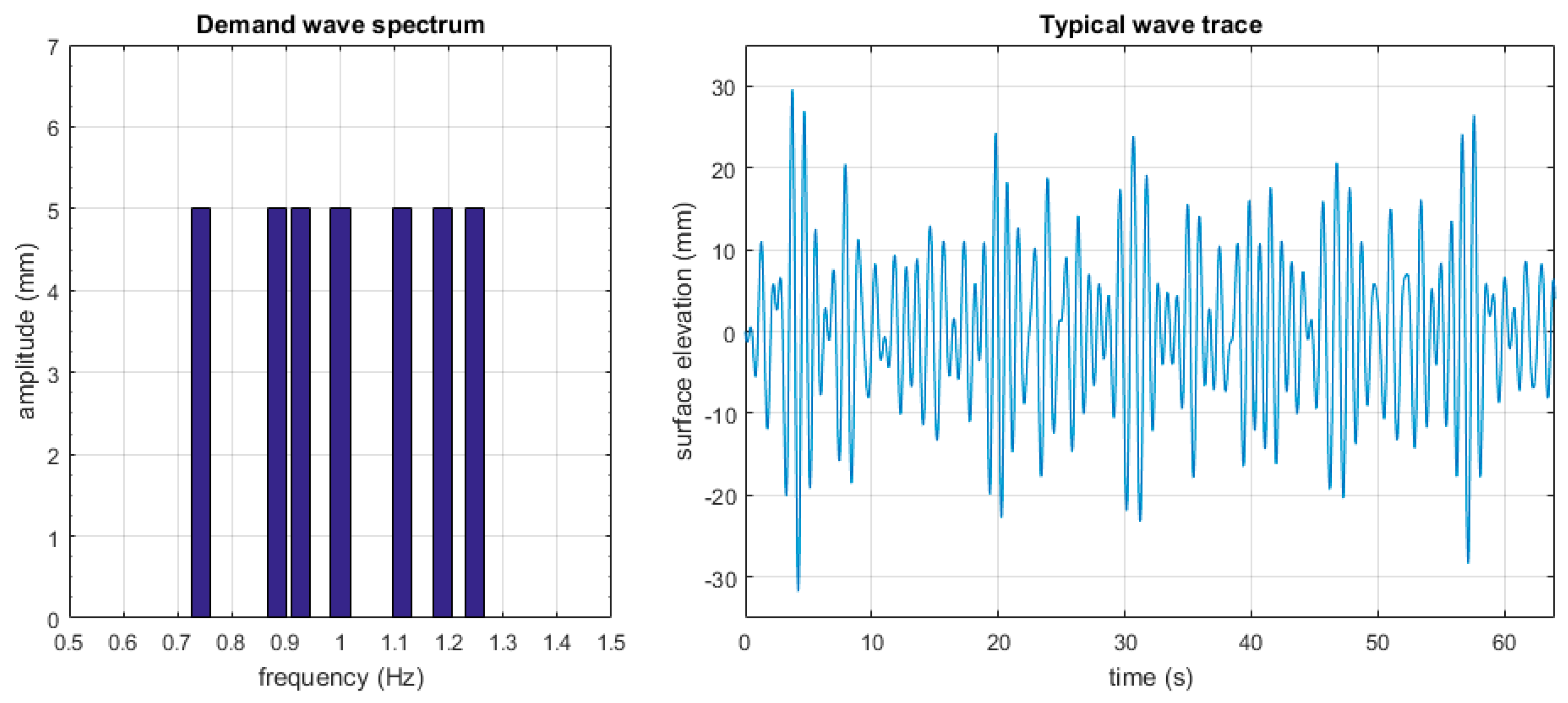
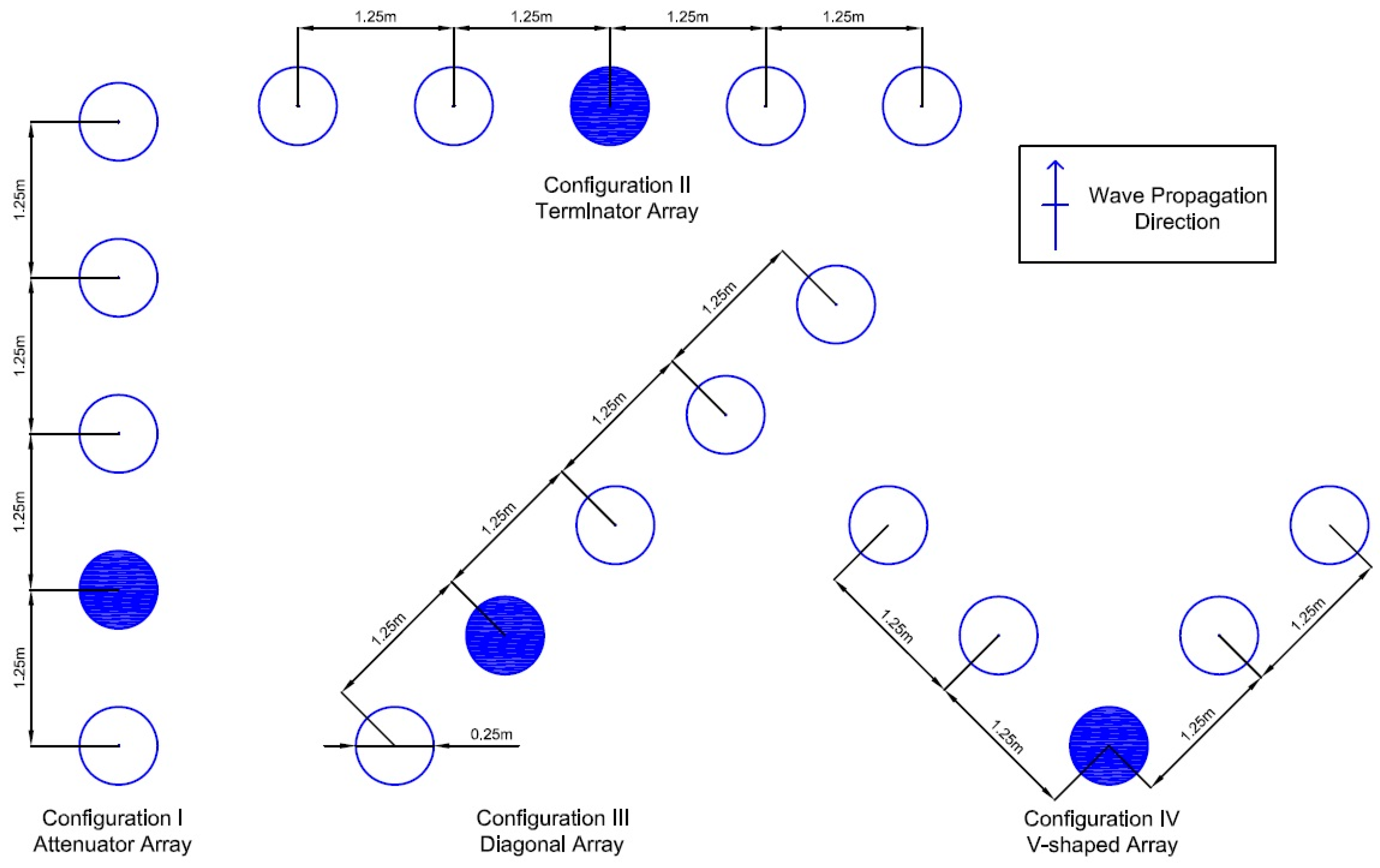
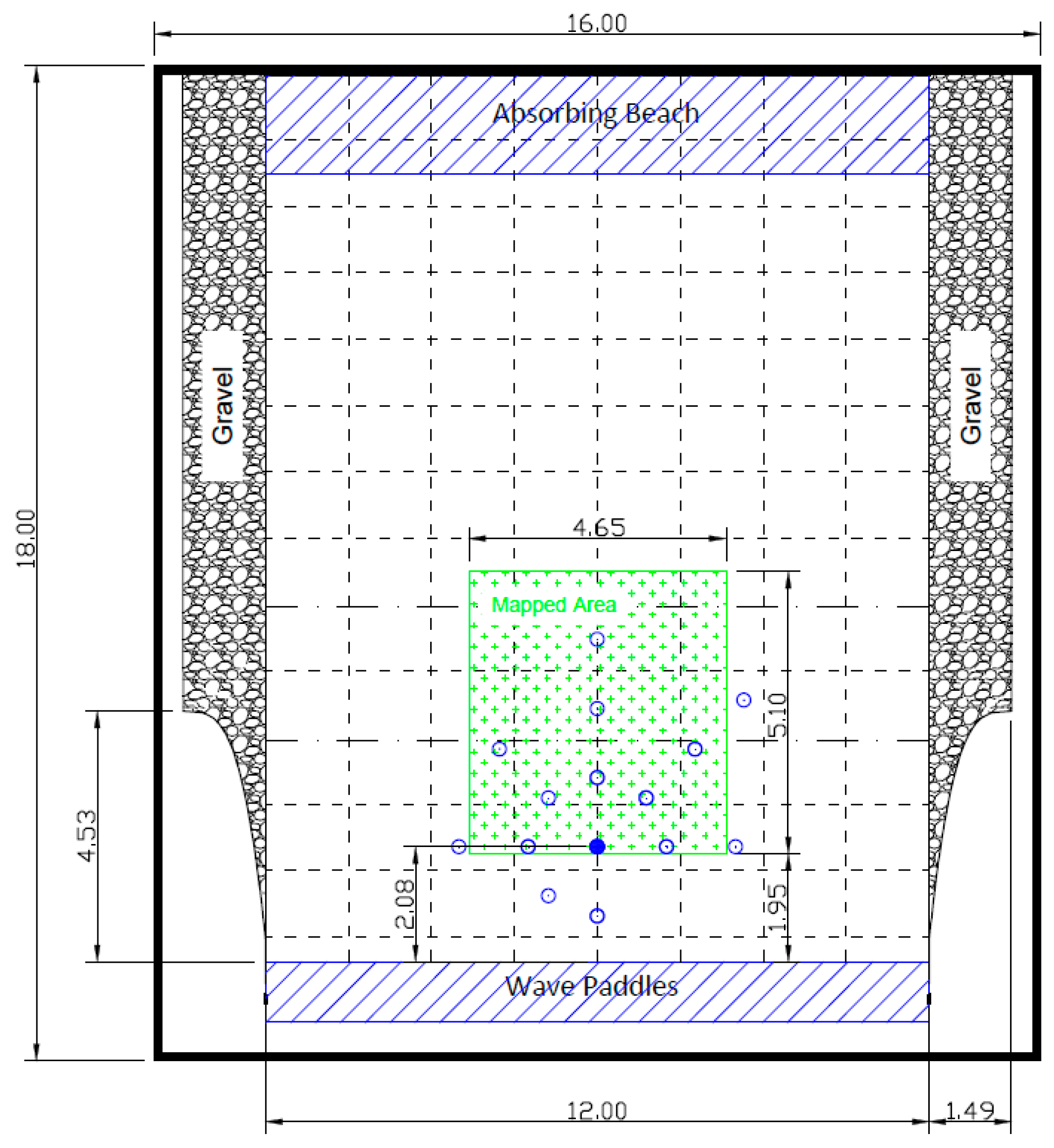
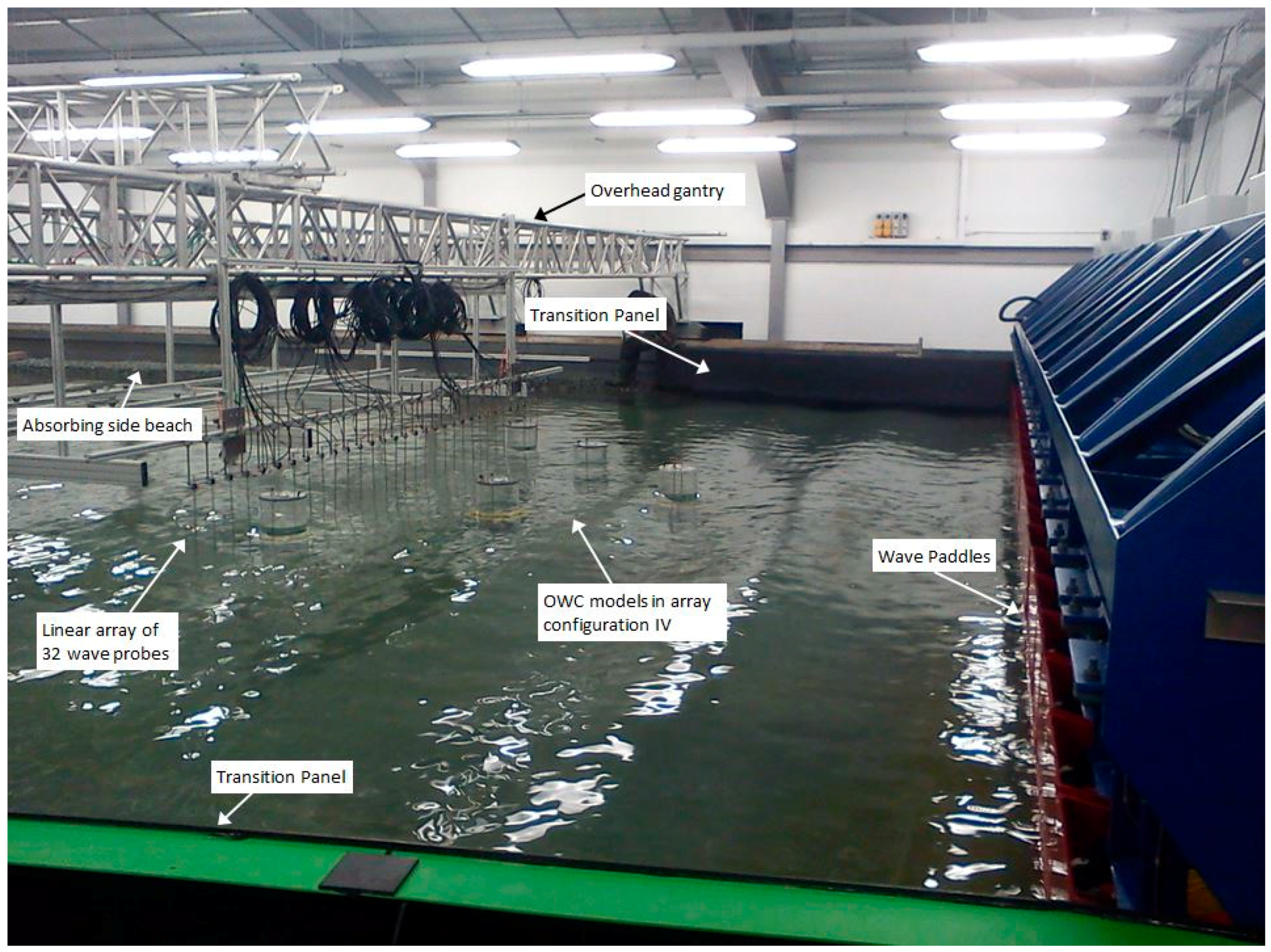


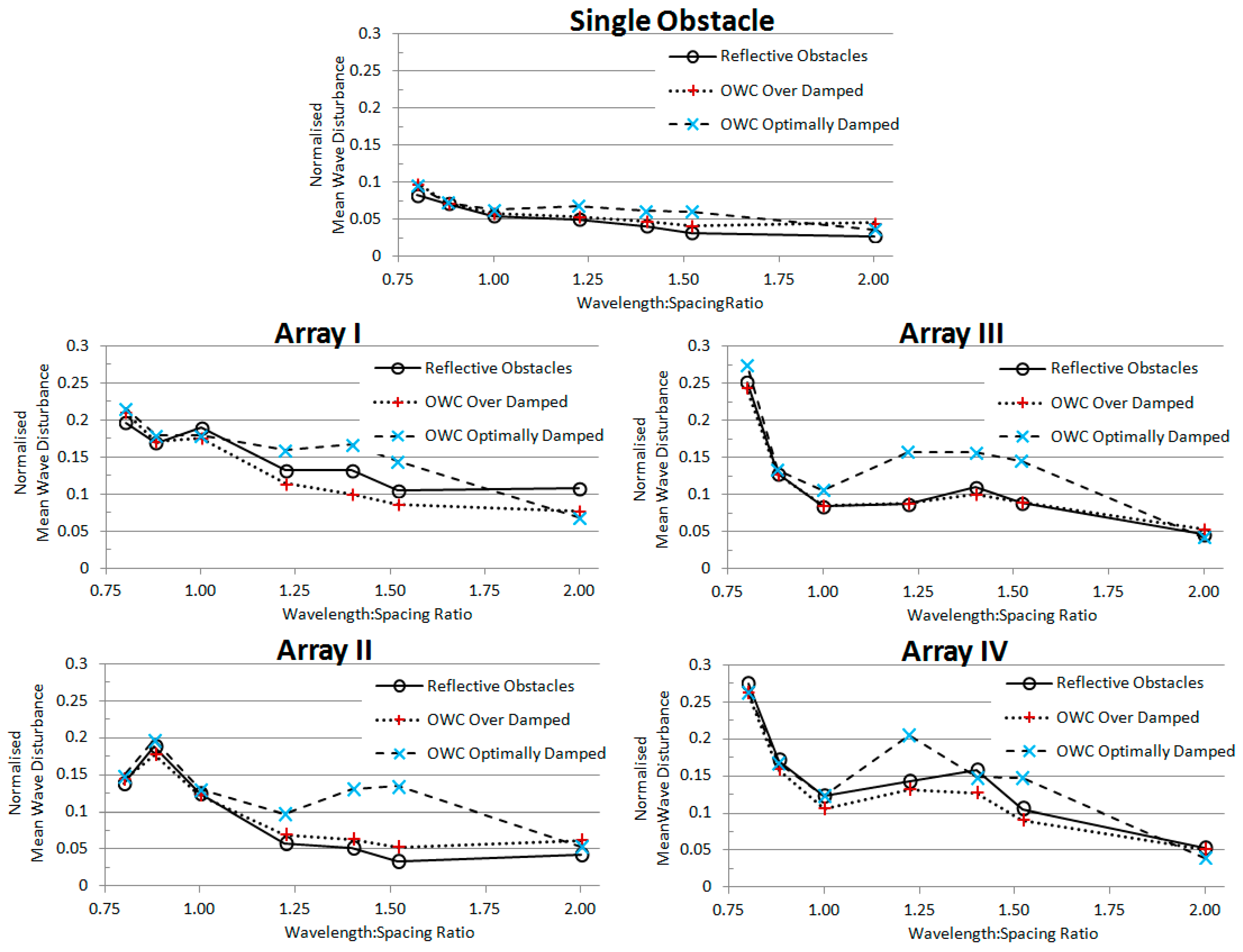
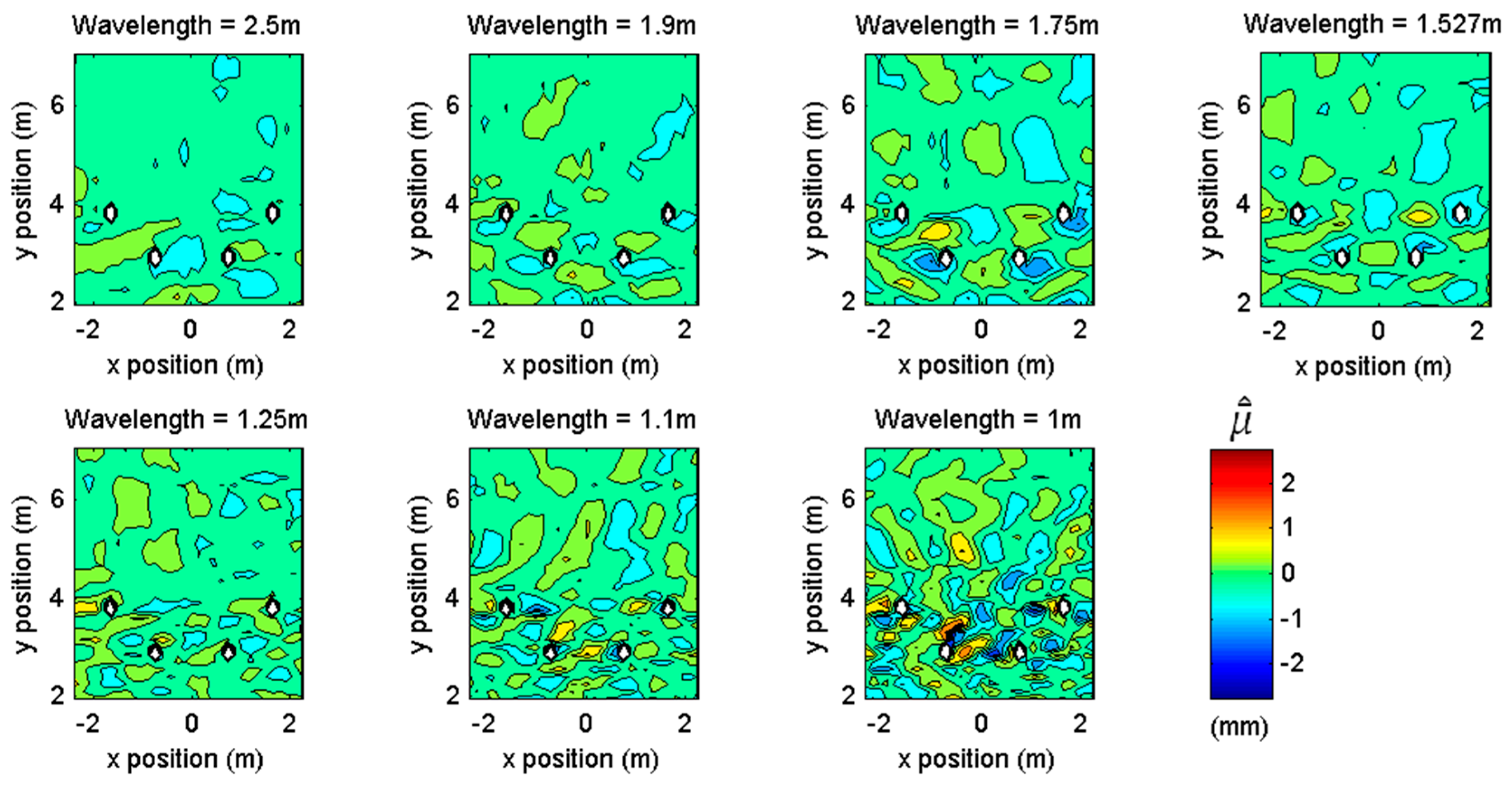

| f (Hz) | λ (m) | (mm) | λ/S | λ/D |
|---|---|---|---|---|
| 0.734 | 2.5 | 5 | 2 | 10 |
| 0.890 | 1.9 | 5 | - | - |
| 0.922 | 1.75 | 5 | 1.4 | 7 |
| 1.000 | 1.53 | 5 | - | - |
| 1.109 | 1.25 | 5 | 1 | 5 |
| 1.1875 | 1.10 | 5 | - | - |
| 1.250 | 1.00 | 5 | 0.8 | 4 |
© 2017 by the authors; licensee MDPI, Basel, Switzerland. This article is an open access article distributed under the terms and conditions of the Creative Commons Attribution (CC-BY) license (http://creativecommons.org/licenses/by/4.0/).
Share and Cite
O’Boyle, L.; Elsäßer, B.; Whittaker, T. Experimental Measurement of Wave Field Variations around Wave Energy Converter Arrays. Sustainability 2017, 9, 70. https://doi.org/10.3390/su9010070
O’Boyle L, Elsäßer B, Whittaker T. Experimental Measurement of Wave Field Variations around Wave Energy Converter Arrays. Sustainability. 2017; 9(1):70. https://doi.org/10.3390/su9010070
Chicago/Turabian StyleO’Boyle, Louise, Björn Elsäßer, and Trevor Whittaker. 2017. "Experimental Measurement of Wave Field Variations around Wave Energy Converter Arrays" Sustainability 9, no. 1: 70. https://doi.org/10.3390/su9010070





